Thai Coconut Pumpkin Curry
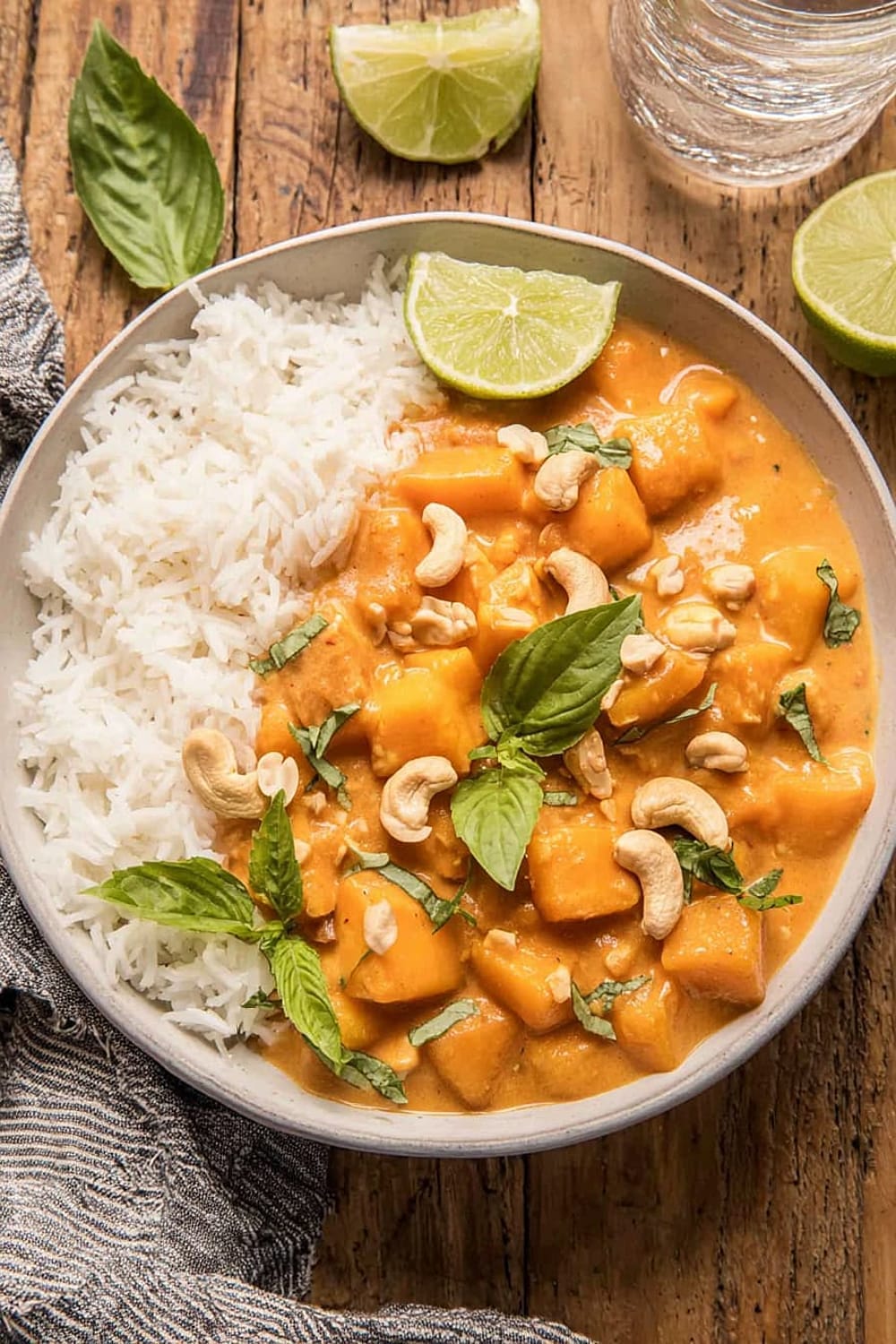
This Thai coconut pumpkin curry is basically what happens when fall comfort food meets exotic vacation vibes, and honestly, it’s the best of both worlds.
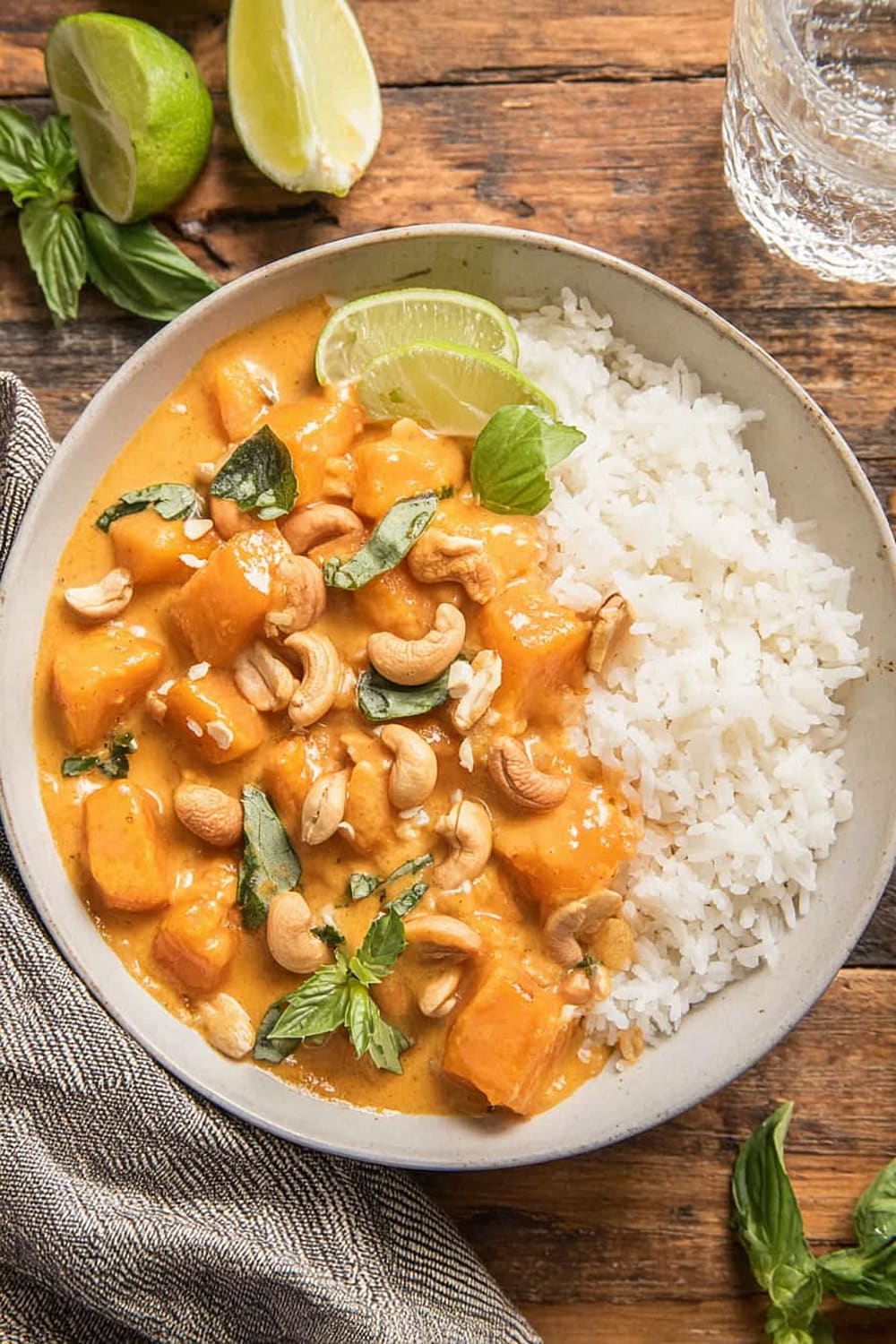
The silky coconut milk transforms humble pumpkin chunks into something that tastes like it came from a fancy Thai restaurant, but you’re making it in your regular old kitchen wearing whatever you want.
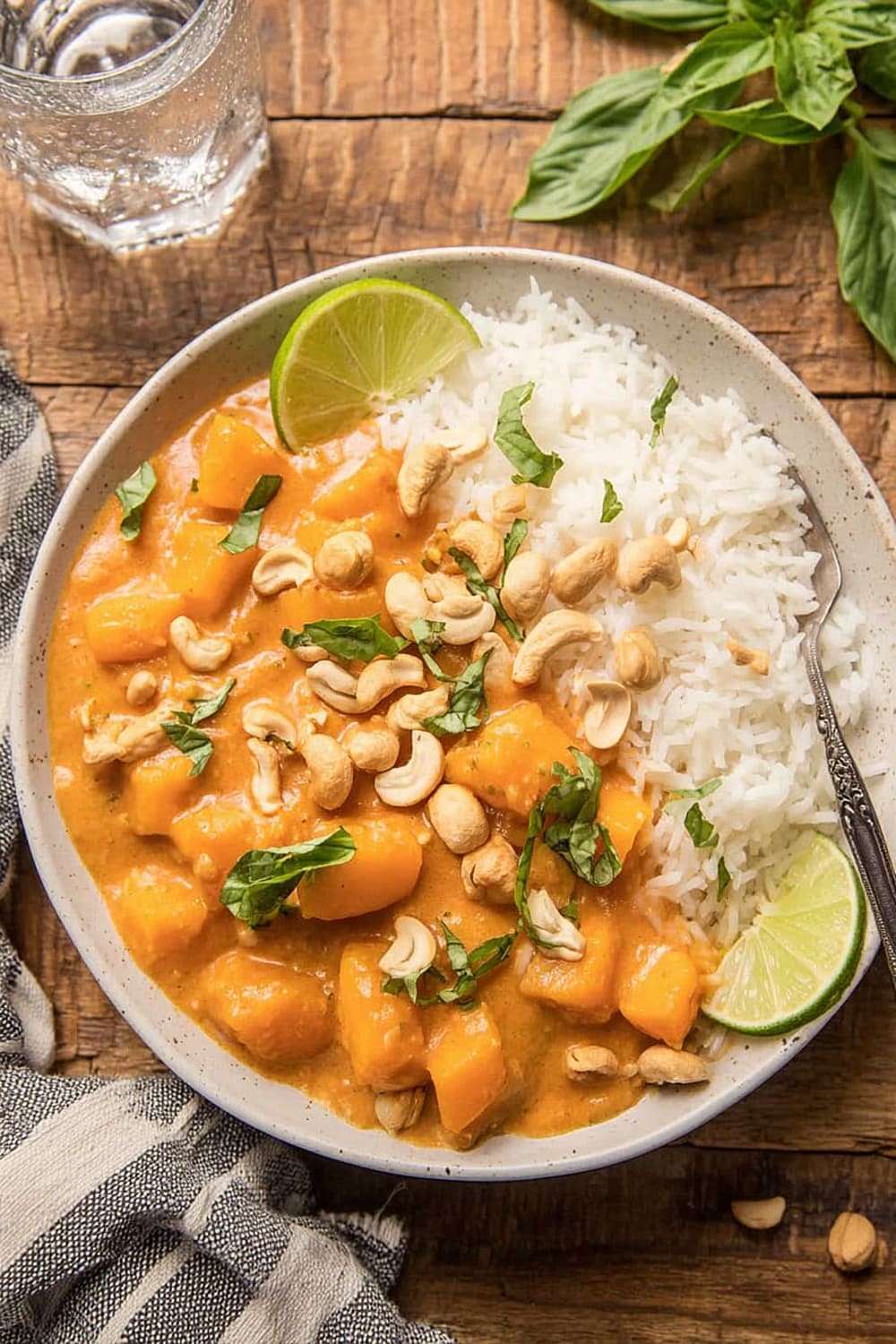
Every spoonful delivers this perfect balance of creamy sweetness from the coconut milk, warm spice from the red curry paste, and that earthy pumpkin flavor that screams cozy autumn nights.
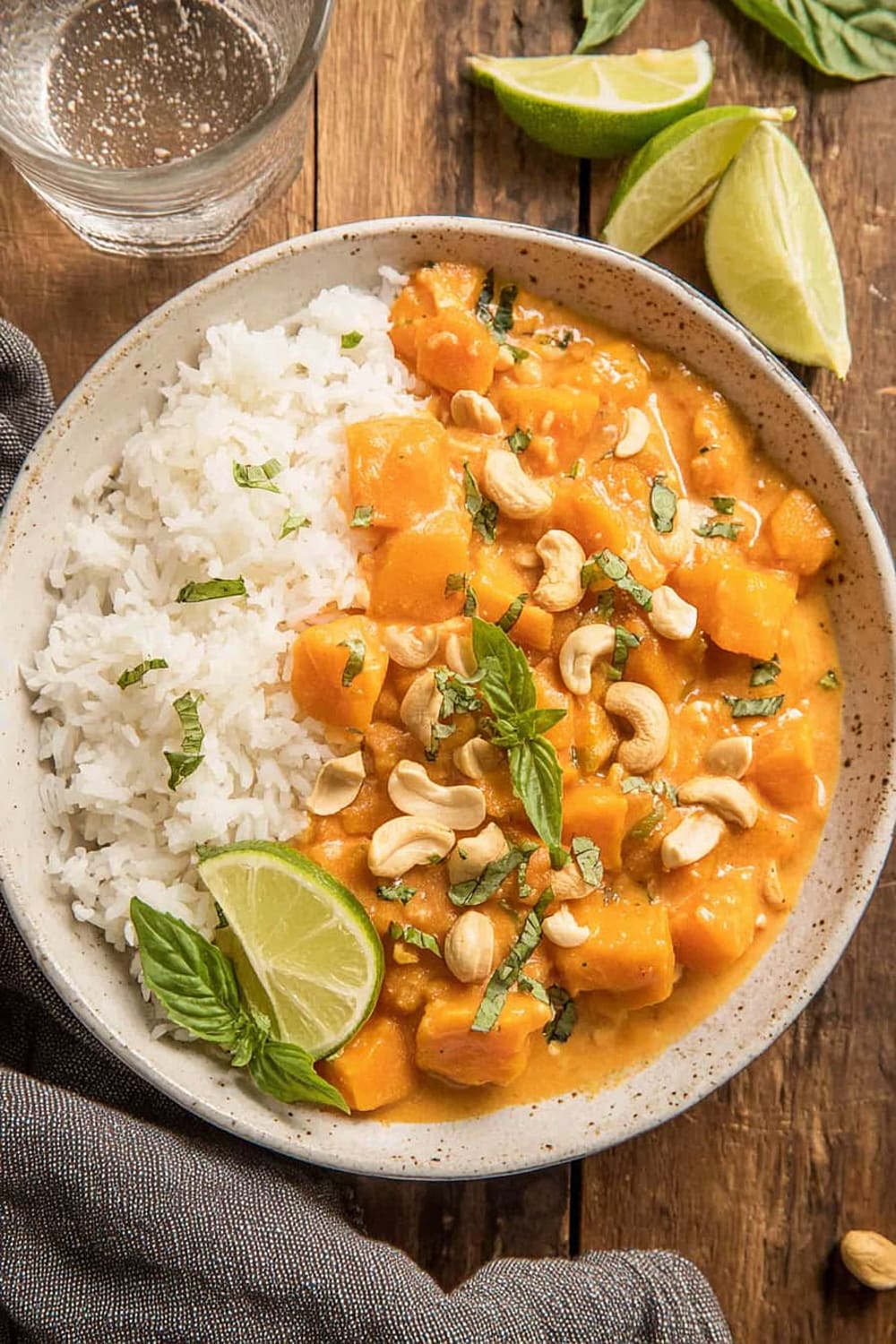
The fresh basil and lime juice at the end add this bright, herbaceous pop that cuts through all that rich coconut goodness and makes your taste buds do a little happy dance.
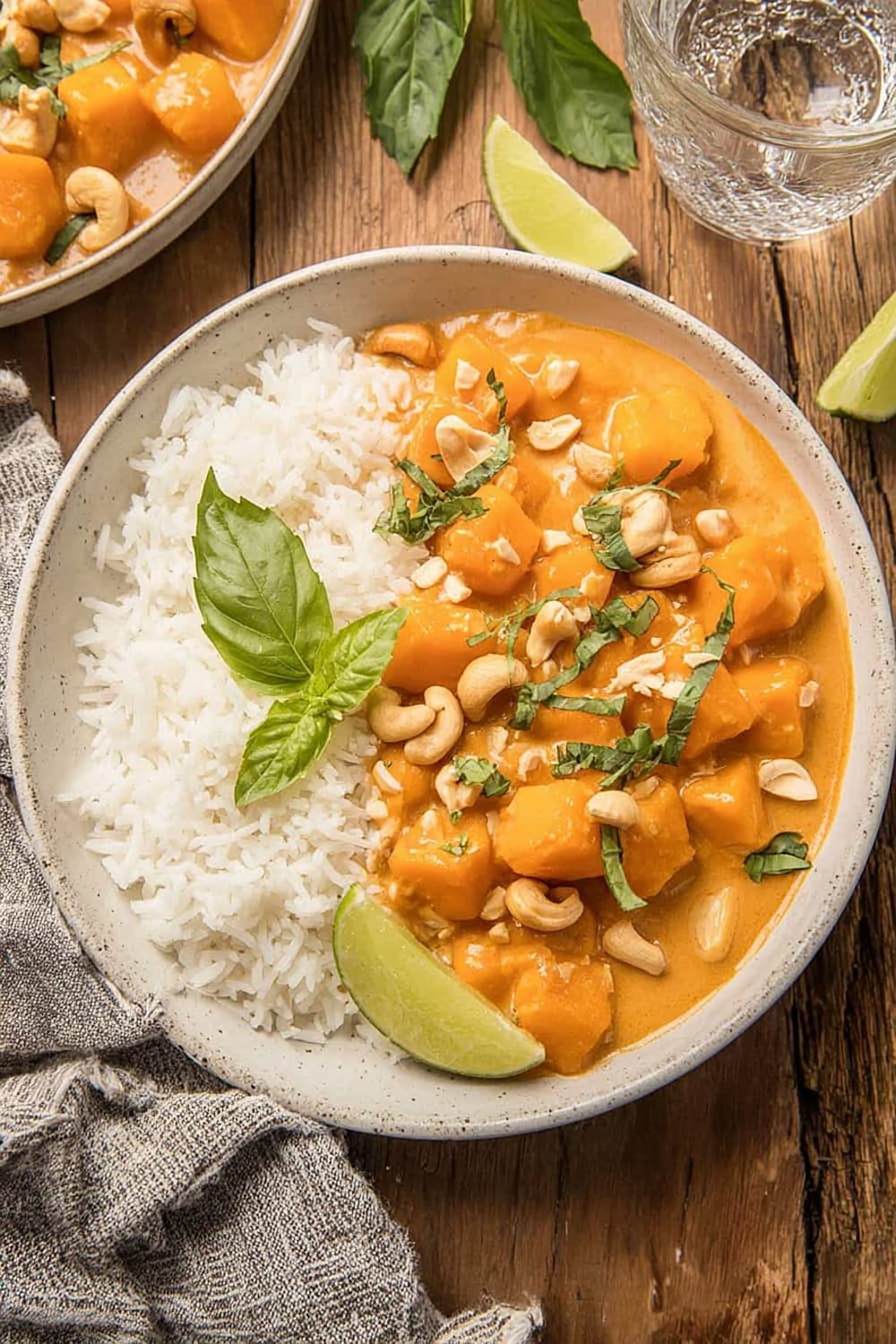
Plus, the whole thing comes together in under an hour, which means you can have restaurant-quality curry on a Tuesday night without breaking a sweat or your budget.
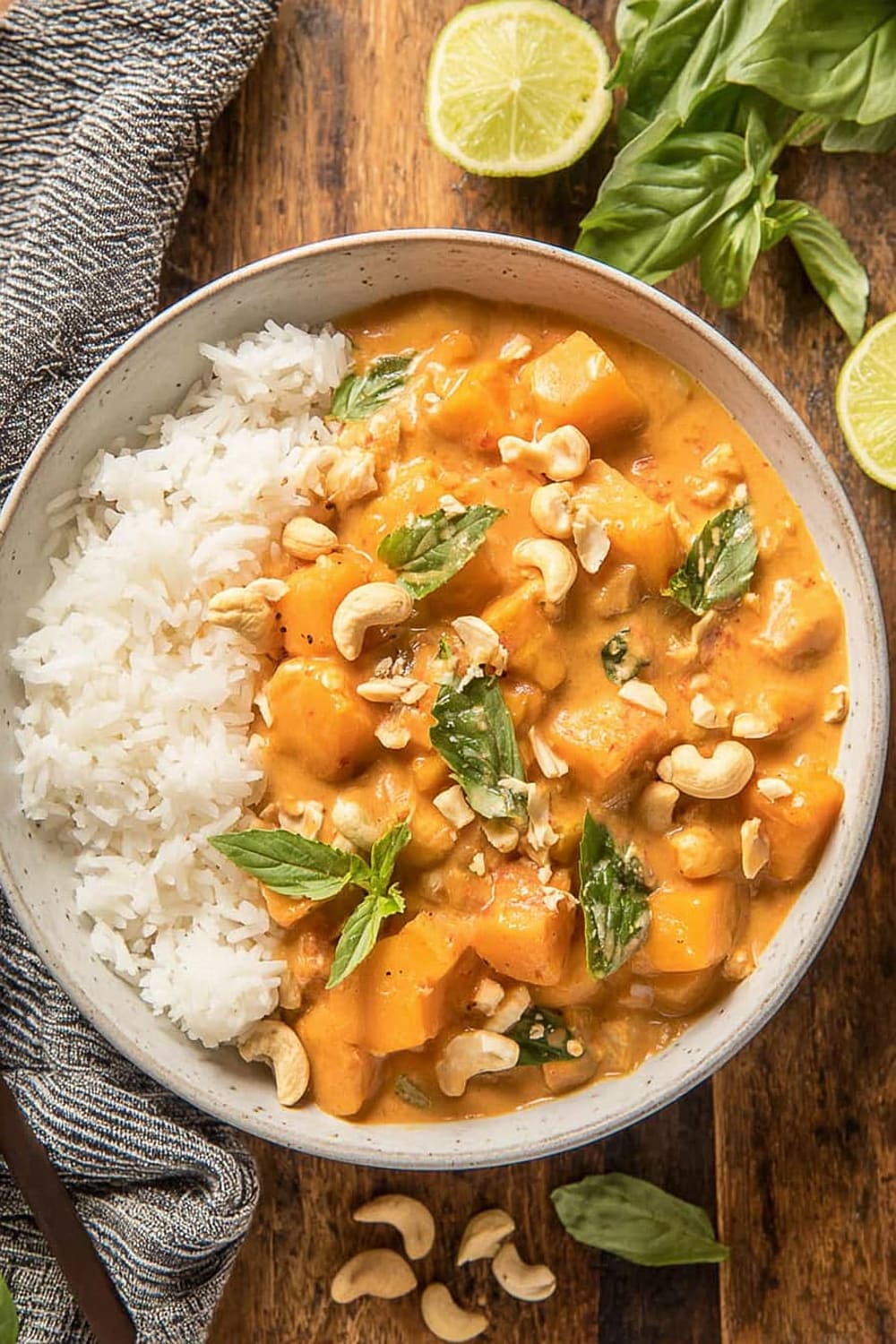
Fair warning: making this will result in your kitchen smelling absolutely incredible, and you’ll probably catch yourself stirring the pot just to release more of those amazing curry paste and coconut aromas.
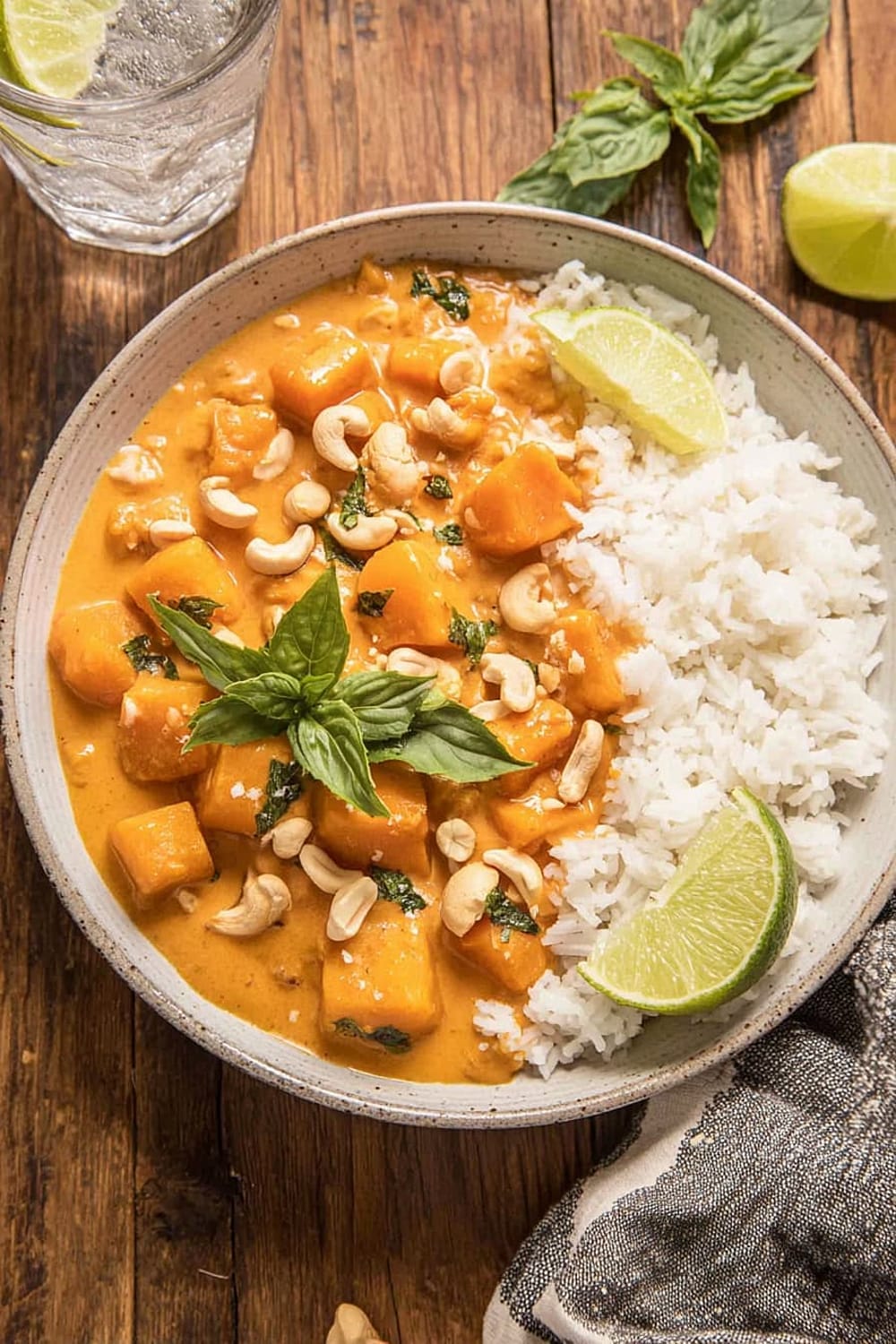
Ingredients
For the curry base
- 1 tablespoon peanut oil (or high-heat oil of choice)
- 1 medium onion, diced
- 2 garlic cloves, minced
- 1 teaspoon fresh ginger
- 3 tablespoons vegan red curry paste, plus more to taste (up to 5 tablespoons)
- ¼ teaspoon ground cinnamon
For the main curry
- 2 pounds fresh sugar pumpkin, peeled and cut into 1-inch pieces (you’ll need about 1 small to medium-sized sugar pumpkin)
- 1 (14 ounce or 400 ml) can full-fat coconut milk
- 2 tablespoons organic brown sugar, plus more to taste
- 1 tablespoon fresh lime juice
- ¼ cup chopped fresh basil, packed
- ½ teaspoon salt, plus more to taste
For serving
- ¼ cup roasted cashews
- Cooked rice, for serving
Instructions
Prepare the aromatic base
- 1 Coat the bottom of a large pot with the 1 tablespoon peanut oil and place it over medium heat. The oil should shimmer slightly when it’s ready, which takes about 2-3 minutes. Using a heavy-bottomed pot or Dutch oven helps distribute heat evenly and prevents the aromatics from burning.
- 2 When the oil is hot, add the diced onion. Sweat the onion for about 5 minutes, stirring occasionally with a wooden spoon, until it begins to soften up and become translucent. You’ll know it’s ready when the onion pieces look glassy and have lost their sharp white color. This slow cooking process develops the onion’s natural sweetness.
Build the flavor foundation
- 3 Stir in the minced garlic, fresh ginger, 3 tablespoons red curry paste, and ¼ teaspoon ground cinnamon. Sauté everything for about 1 minute, stirring constantly to prevent burning, until the mixture becomes very fragrant. The curry paste will darken slightly and release its oils, creating an incredibly aromatic base. If the mixture starts to stick, lower the heat slightly.
Create the curry
- 4 Stir in the pumpkin pieces, full can of coconut milk, and 2 tablespoons of brown sugar. Make sure to scrape up any browned bits from the bottom of the pot as you stir. Raise the heat to medium-high and bring the liquid to a rolling boil, which should take about 3-4 minutes. You’ll see bubbles breaking the surface consistently.
- 5 Lower the heat to medium-low and cover the pot with a tight-fitting lid. Simmer the curry for 5 minutes with the lid on to steam the pumpkin, then remove the lid and continue simmering for about 10 minutes, stirring occasionally. The sauce should thicken noticeably and coat the back of a spoon, while the pumpkin becomes fork-tender but still holds its shape.
Finish and serve
- 6 Remove the pot from heat and stir in the fresh basil, lime juice, and ½ teaspoon salt. Taste and adjust any seasonings to your liking – you might want more curry paste for heat, brown sugar for sweetness, or lime juice for brightness. The flavors should be balanced between creamy, spicy, sweet, and tangy.
- 7 Serve the curry over cooked rice with roasted cashews sprinkled on top. The curry is best served immediately while hot, but the flavors actually improve after sitting for 10-15 minutes to meld together.
Recommended Equipment and Kitchen Tools
Essential Tools (for best results)
- Large heavy-bottomed pot or Dutch oven – Provides even heat distribution and prevents the curry paste from burning during the initial sautéing phase
- Sharp chef’s knife – Makes quick work of dicing the onion and cutting pumpkin into uniform pieces for even cooking
- Wooden spoon or silicone spatula – Won’t scratch your pot’s surface and handles the thick curry paste without melting
- Cutting board with grooves – Catches pumpkin juice and makes cleanup easier when prepping the fresh ingredients
Helpful Upgrades
- Immersion blender – Perfect if you prefer a partially smooth curry texture, though the chunky version is traditional and delicious
- Microplane grater – Makes grating fresh ginger effortless and ensures no fibrous pieces in your curry
- Cast iron Dutch oven – Superior heat retention means more even cooking and better flavor development
- Digital kitchen scale – Ensures consistent results when measuring the pumpkin and curry paste
Nice-to-Have Options
- Fine-mesh strainer – Useful for straining the coconut milk if it has separated, though shaking the can usually works fine
- Mortar and pestle – Traditional tool for making your own curry paste from scratch if you’re feeling adventurous
- Storage containers with tight lids – This curry keeps beautifully in the refrigerator and tastes even better the next day
Recipe Variations and Dietary Modifications
Protein Additions
- Firm tofu – Add 14 oz cubed extra-firm tofu in step 4 with the pumpkin for a heartier meal
- Chickpeas – Stir in 1 can drained chickpeas during the last 5 minutes of simmering
- Chicken or shrimp – Add 1 lb protein after step 3, cook until done, then proceed with pumpkin
- Tempeh – Crumble 8 oz tempeh and brown it before adding the onions for extra texture
Vegetable Variations
- Butternut squash – Substitute equal amounts of butternut squash for pumpkin, cooking time remains the same
- Sweet potato – Use 2 lbs sweet potatoes cut into chunks, may need 5 extra minutes cooking time
- Mixed vegetables – Add bell peppers, snap peas, or baby corn in the last 5 minutes of cooking
- Leafy greens – Stir in 2 cups spinach or bok choy just before serving
Spice Level Adjustments
- Mild version – Start with 2 tablespoons curry paste and add 1 teaspoon coconut sugar to balance heat
- Extra spicy – Use up to 5 tablespoons curry paste and add 1 sliced Thai chili with the garlic
- Different curry pastes – Try green curry paste for herbaceous heat or yellow curry paste for milder flavor
Coconut Milk Alternatives
- Light coconut milk – Reduces calories but creates a thinner consistency, add 1 tablespoon cornstarch if needed
- Coconut cream – Creates an ultra-rich curry, thin with ½ cup vegetable broth
Nutritional Information and Health Benefits
Key Nutritional Highlights
This Thai coconut pumpkin curry provides approximately 323 calories per serving, making it a satisfying yet reasonable meal option. The primary macronutrients come from the coconut milk’s healthy fats (18g per serving), the pumpkin’s complex carbohydrates (28g per serving), and a moderate protein content (6g per serving) from the cashews and coconut milk. Each serving delivers an impressive 8 grams of fiber, primarily from the pumpkin, which supports digestive health and helps maintain stable blood sugar levels.
Health Benefits of Main Ingredients
The fresh pumpkin serves as a nutritional powerhouse, loaded with beta-carotene that converts to vitamin A in the body, supporting eye health and immune function. One serving provides over 200% of your daily vitamin A needs. The coconut milk contains medium-chain triglycerides (MCTs), which may boost metabolism and provide quick energy for the brain. Red curry paste includes anti-inflammatory compounds from chilies, garlic, and lemongrass, while the fresh ginger adds digestive benefits and natural anti-inflammatory properties. The fresh basil contributes antioxidants and essential oils that may help reduce stress and support respiratory health.
Dietary Considerations
This curry is naturally vegan, gluten-free, and dairy-free, making it suitable for most dietary restrictions. The dish contains tree nuts (cashews) and may contain soy depending on the curry paste brand used. The coconut milk provides healthy saturated fats that support hormone production, while the fiber-rich pumpkin helps maintain steady energy levels throughout the day.
Smart Swaps and Ingredient Substitutions
Common Substitutions:
- Peanut oil → Avocado oil, coconut oil, or vegetable oil (use same amount, coconut oil adds subtle coconut flavor)
- Fresh ginger → Ground ginger (use ¼ teaspoon ground for every 1 teaspoon fresh)
- Red curry paste → Green curry paste for herbaceous heat, or yellow curry paste for milder flavor
- Fresh pumpkin → Butternut squash, sweet potato, or kabocha squash (same amount, similar cooking time)
Budget-Friendly Swaps:
- Full-fat coconut milk → Light coconut milk plus 2 tablespoons coconut cream (costs less, similar richness)
- Fresh basil → Dried basil (use 1 tablespoon dried for ¼ cup fresh, add at the end)
- Roasted cashews → Toasted peanuts or sunflower seeds (fraction of the cost, similar crunch)
- Organic brown sugar → Regular brown sugar or coconut sugar (same sweetness level)
Pantry Emergency Substitutions:
- Fresh lime juice → Lemon juice or rice vinegar (start with half the amount, adjust to taste)
- Fresh ginger → Ground ginger or ginger paste (¼ teaspoon ground or ½ teaspoon paste)
- Sugar pumpkin → Canned pumpkin puree (use 2 cups, add in step 5 for last 5 minutes only)
- Red curry paste → 1 tablespoon curry powder plus 1 teaspoon chili paste (different flavor but still delicious)
Pro Tips for Substitutions:
- Canned coconut milk separates naturally – shake the can vigorously before opening for smooth consistency
- When using frozen pumpkin, thaw completely and drain excess liquid to prevent watery curry
- Homemade curry paste can be made ahead and frozen in ice cube trays for future use
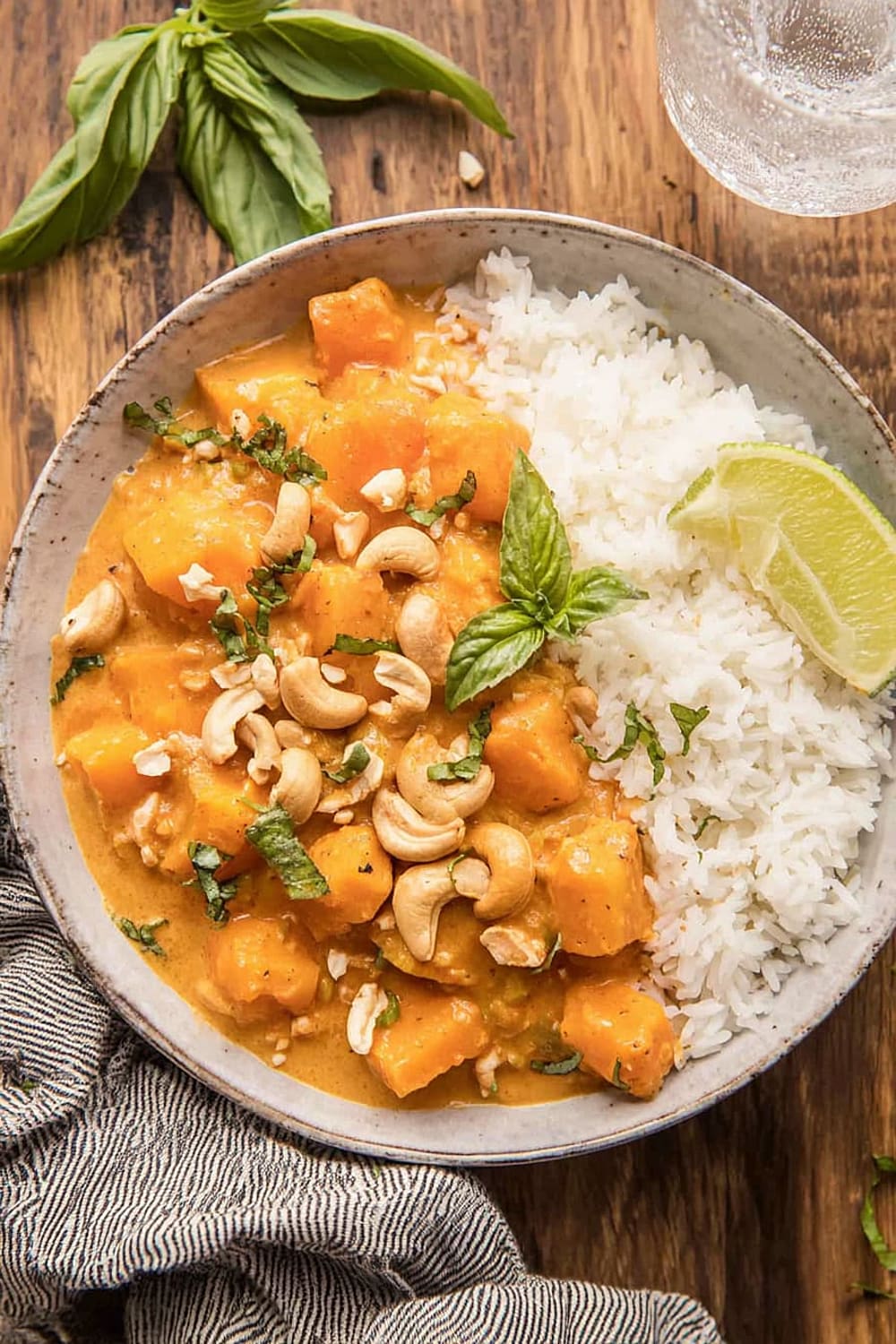
Make It Diabetes-Friendly
Sugar Substitutions:
- Replace 2 tablespoons brown sugar with 1 tablespoon sugar-free brown sugar substitute or 1 teaspoon stevia
- Monk fruit sweetener works excellently in this recipe – use 1 teaspoon to replace the brown sugar
- Erythritol provides similar sweetness – use 1½ tablespoons to replace the brown sugar
- This reduces carbs by approximately 24 grams per batch (6 grams per serving)
Carb Reduction Strategies:
- Serve over cauliflower rice instead of regular rice to save 35-40 grams carbs per serving
- Use shirataki rice or konjac rice for an ultra-low carb base (2 grams carbs vs 45 grams for white rice)
- Reduce pumpkin to 1½ pounds and add 1 cup diced zucchini to lower overall carb content
- Add extra protein like tofu or tempeh to increase satiety without adding carbs
Portion & Blood Sugar Management:
- Stick to 1 cup curry per serving (about 20 grams net carbs with sugar substitutions)
- Pair with 2 tablespoons extra cashews or ¼ avocado to slow glucose absorption
- The healthy fats from coconut milk naturally help stabilize blood sugar response
- Fresh lime juice may help lower the glycemic impact of the meal
Total Carb Reduction: Original recipe contains approximately 28 grams carbs per serving; modified version contains 14 grams net carbs per serving when served over cauliflower rice with sugar substitutes.
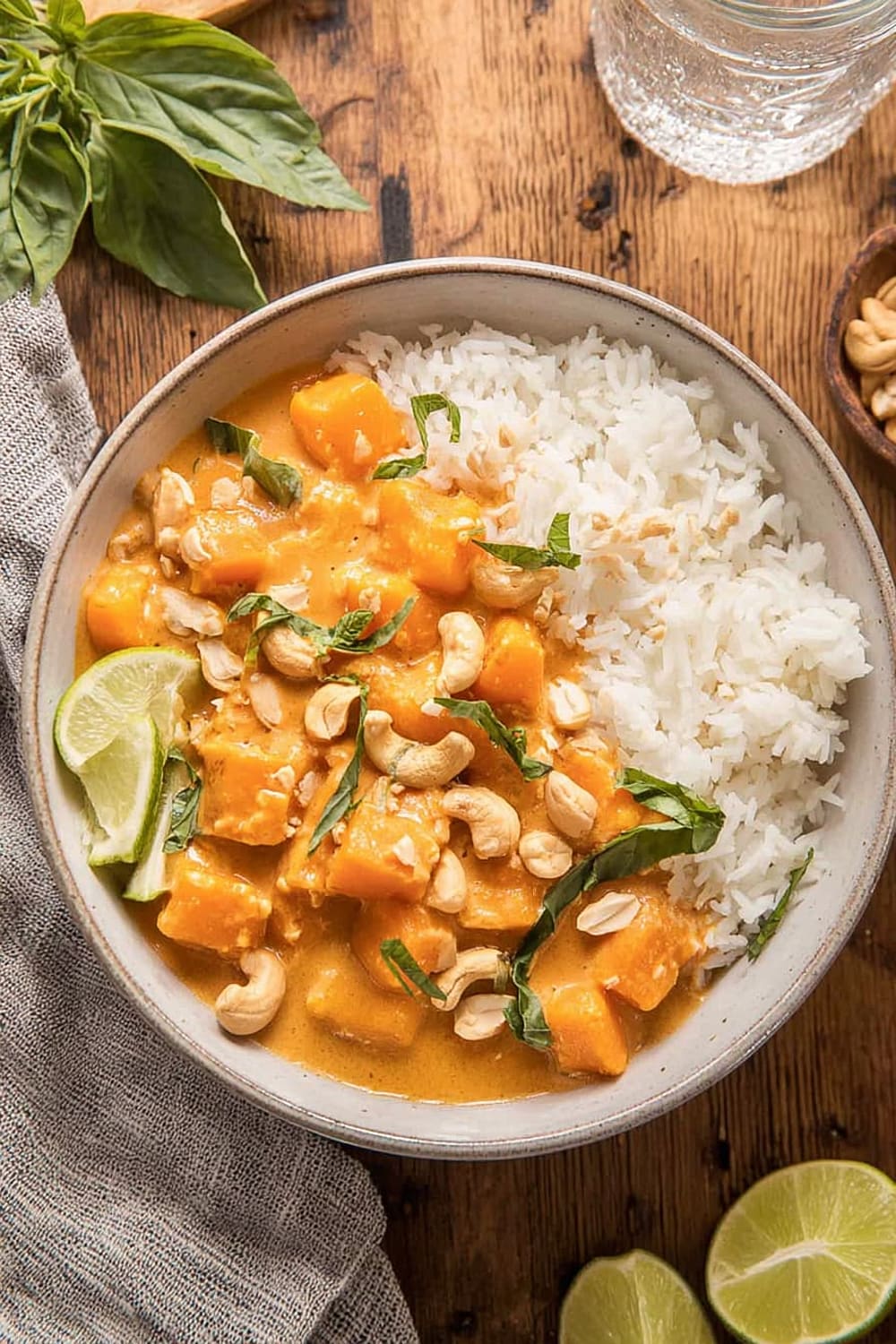
Perfect Pairing Suggestions
Beverage Pairings
The rich, creamy coconut base and warm spices in this curry pair beautifully with crisp white wines like Riesling or Gewürztraminer, which complement the sweetness while cutting through the richness. For beer lovers, a wheat beer or Belgian witbier provides citrusy notes that echo the lime juice, while Thai iced tea or coconut water offer non-alcoholic options that enhance the Southeast Asian flavors. Green jasmine tea served hot cleanses the palate between bites and aids digestion.
Side Dish Recommendations
Cucumber salad with rice vinegar dressing provides cooling contrast to the curry’s warmth, while steamed broccoli or green beans add fresh crunch and nutritional balance. Coconut rice made with half coconut milk amplifies the tropical flavors, and naan bread or rice crackers help scoop up every drop of that delicious sauce. For a complete Thai-inspired meal, serve alongside fresh spring rolls or papaya salad to create textural variety.
Complete Meal Ideas
Start with tom yum soup or coconut soup as an appetizer to warm up the palate, then follow this curry with mango sticky rice or coconut ice cream for dessert. For casual entertaining, set up a curry bar with different toppings like crushed peanuts, fresh herbs, lime wedges, and chili oil so guests can customize their bowls. The curry also works beautifully as part of a Thai feast alongside pad thai and green papaya salad.
Occasion Suggestions
This curry shines during autumn dinner parties when pumpkins are at their peak, and makes an excellent Meatless Monday option that even carnivores will love. It’s perfect for cozy date nights or family dinners when you want something exotic but not too challenging for picky eaters.
Pro Tips and Troubleshooting
Professional Techniques
Always bloom your curry paste in the oil for that full minute – this step develops deeper, more complex flavors that separate homemade curry from bland versions. Cut pumpkin pieces uniformly to ensure even cooking; pieces that are too large will be hard in the center while small pieces turn to mush. Taste and adjust seasonings at the end – curry paste brands vary significantly in salt and heat levels, so your palate is the best guide. Let the curry rest for 10-15 minutes after cooking to allow flavors to meld and the sauce to thicken naturally.
Common Mistakes and Solutions
If your curry turns out too watery, simmer uncovered for an additional 10-15 minutes to reduce the liquid, or whisk in 1 tablespoon cornstarch mixed with 2 tablespoons cold water. Grainy or separated coconut milk usually means the heat was too high – lower the temperature and whisk vigorously to re-emulsify. Overly salty curry can be balanced with additional coconut milk and a pinch of brown sugar, while bland curry needs more curry paste and a splash of fish sauce or soy sauce for umami depth.
Storage and Make-Ahead Strategies
This curry improves overnight in the refrigerator as flavors develop and meld together. Store covered for up to 5 days and reheat gently on the stovetop, adding a splash of coconut milk if it seems thick. Freeze portions in individual containers for up to 3 months – the texture remains excellent after thawing. For meal prep, cook the curry completely but store the rice separately to prevent mushiness.
Scaling and Presentation
Double the recipe easily for meal prep or entertaining, but use a larger pot to prevent overflow when bringing to a boil. Garnish thoughtfully with fresh basil leaves, lime wedges, and a sprinkle of red pepper flakes for restaurant-quality presentation that photographs beautifully.
This Thai coconut pumpkin curry proves that restaurant-quality flavors are absolutely achievable in your own kitchen, and the best part is watching people’s faces light up when they take that first creamy, aromatic spoonful that somehow tastes like autumn and vacation rolled into one perfect bowl.